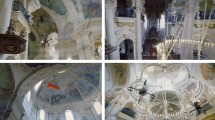Abstract
In this work, the authors propose a formation control strategy of a group of three multirotor aerial vehicles being able to avoid multiple obstacles and collisions. To deal with this problem, a decentralized architecture is proposed which has one model predictive controller per vehicle including a set of convex constraints on the vehicle’s position to prevent collisions with other agents and different shapes of obstacles. The resulting decentralized scheme controls the formation based on a virtual structure approach. For the purpose of avoiding collisions, each local controller considers the predicted position of every neighbor vehicles. The effectiveness of the developed scheme is demonstrated through numerical simulations considering a “figure-of-eight” as the reference trajectory, and the results show its capability to handle thrust force, obstacle and collision avoidance constraints.









Similar content being viewed by others
References
Goncalves RS, Carvalho JCM (2015) A mobile robot to be applied in high-voltage power lines. J Braz Soc Mech Sci Eng 37(1):349–359
Kamarlouei M, Ghassemi H (2016) Robust control for horizontal plane motions of autonomous underwater vehicles. J Braz Soc Mech Sci Eng 38(7):1921–1934
Wang X, Yadav V, Balakrishnan SN (2007) Cooperative uav formation flying with obstacle/collision avoidance. IEEE Trans Control Syst Technol 15(4):672–679
Korayem MH, Nazemizadeh M, Nohooji HR (2014) Optimal point-to-point motion planning of non-holonomic mobile robots in the presence of multiple obstacles. J Braz Soc Mech Sci Eng 36(1):221–232
Schouwenaars T, Feron E, How J (2006) Multi-vehicle path planning for non-line of sight communication. In Proceedings...American control conference, vol 1. IEEE, Piscataway, p 6
Kuwata Y, How J (2003) Real-time trajectory design for unmanned aerial vehicles using receding horizon control. M.S.thesis, Aeronautics Astronautics, Massachusetts Inst. Technol., Boston
Lewis MA, Tan KH (1997) High precision formation control of mobile robots using virtual structures. Auton Robot 4:387–403
Das AK, Fierro R, Kumar V, Ostrowski JP, Spletzer J, Taylor CJ (2002) A vision-based formation control framework. IEEE Trans Robot Autom 18(5):813–825
Balch T, Arkin RC (1998) Behavior-based formation control of multirobot teams. IEEE Trans Robot Autom 14(6):926–939
Mansouri SS, Nikolakopoulos G, Gustafsson T (2016) Distributed model predictive control for unmanned aerial vehicles. In Proceedings... workshop on research, education and development of unmanned aerial systems (RED-UAS). IEEE, Piscataway, pp 152–161
Chao Z, Ming L, Shaolei Z, Wenguang Z (2013) Collision-free uav formation flight control based on nonlinear MPC. In Proceedings... AIAA guidance, navigation and control conference and exhibit. AIAA
Viana ÍB, Santos DA, Góes LCS, Prado IAA (2017) Distributed formation flight control of multirotor helicopters. J Control Autom Electr Syst 28(4):502–515
Richards A, Schouwenaars T, How J, Feron E (2002) Spacecraft trajectory planning with avoidance constraints using mixed-integer linear programming. J Guid Control Dyn 25:755–764
Santos DA (2013) Automatic position control of multirotor helicopters. Technical report, ESIEE Paris, Postdoctoral Final Report, ESIEE Paris
Maciejowski JM (2002) Predictive control with constraints. Prentice-Hall, Harlow
Bemporad A, Morari M (1999) Control of systems integrating logic, dynamics, and constraints. Automatica 35:407–427
IBM (2009) IBM ILOG CPLEX V12.1: user’s manual for CPLEX
Santos DA, Cela A, Saotome O (2013) Trajectory control of multirotor helicopters with thrust vector constraints. In Proceedings...mediterranean conference of control and automation (MED). IEEE, pp 375–379
Acknowledgements
The authors acknowledge the support of Conselho Nacional de Desenvolvimento Científico e Tecnológico (CNPq) by the financial support under the research Grant 475251/2013-0. The first author is grateful to CNPq for supporting him with a doctoral scholarship. Finally, all the authors would like to thank Instituto Tecnológico de Aeronáutica (ITA) for the necessary support to realize the present work.
Author information
Authors and Affiliations
Corresponding author
Additional information
Technical Editor: Victor Juliano De Negri.
Rights and permissions
About this article
Cite this article
Viana, Í.B., dos Santos, D.A. & Góes, L.C.S. Formation control of multirotor aerial vehicles using decentralized MPC. J Braz. Soc. Mech. Sci. Eng. 40, 306 (2018). https://doi.org/10.1007/s40430-018-1206-5
Received:
Accepted:
Published:
DOI: https://doi.org/10.1007/s40430-018-1206-5




